- Clone
- MAb-CC1 (See other available formats)
- Regulatory Status
- RUO
- Other Names
- CEACAM1a, Bgp
- Isotype
- Mouse IgG1, κ
- Ave. Rating
- Submit a Review
- Product Citations
- publications
CD66a, known as CEACAM1a, carcinoembryonic antigen-related cell adhesion molecule 1a, is a glycoprotein of the immunoglobulin superfamily and the carcinoembryonic antigen family. Isoforms expressing either two or four alternatively spliced Ig-like domains in mice have been found in a number of epithelial, endothelial, or hematopoietic tissues. CEACAM1a functions as an intercellular adhesion molecule, an angiogenic factor, and a tumor cell growth inhibitor. It also serves as a signal regulatory protein influencing B cell receptor complex-mediated activation. The mouse and human CEACAM1a proteins are targets of viral or bacterial pathogens, respectively. It was reported that targeted disruption of the CEACAM1a gene resulting in a partial ablation of the protein in mice led to reduced susceptibility to virus infection. The antibody recognizes the N-terminal domain of murine CEACAM1a, it does not recognize murine CEACAM1b, an allele in SJL mice.
Product DetailsProduct Details
- Verified Reactivity
- Mouse
- Antibody Type
- Monoclonal
- Host Species
- Mouse
- Immunogen
- SJL/J mice immunized with deoxycholate extracted proteins from BALB/c intestinal brush border membranes.
- Formulation
- Phosphate-buffered solution, pH 7.2, containing 0.09% sodium azide
- Preparation
- The antibody was purified by affinity chromatography and conjugated with Spark Blue™ 550 under optimal conditions.
- Concentration
- 0.2 mg/mL
- Storage & Handling
- The antibody solution should be stored undiluted between 2°C and 8°C, and protected from prolonged exposure to light. Do not freeze.
- Application
-
FC
- Recommended Usage
-
Flexi-Fluors™ are provided at a standard 0.2 mg/mL concentration. We recommend titrating this reagent to determine the optimal concentration for each application. For many flow cytometry applications, conjugated antibodies perform well at concentrations ranging from 0.03 to 1.0 µg per million cells in 100 µL. We recommend testing a range of concentrations starting from 10 µg/mL.
For example, make five 1:1 serial dilutions of the 0.2 mg/mL antibody. Add 5 µL of each dilution (including the undiluted antibody) to 100 µL of cells (at 107 cells/mL) to test six concentrations -- 1.0, 0.5, 0.25, 0.125, 0.06, and 0.03 µg per million cells in 100 µL volume. Compare staining patterns or create a titration curve using the MFI or staining index to determine the optimal concentration.
* Spark Blue™ 550 has a maximum excitation of 516 nm and a maximum emission of 540 nm. - Excitation Laser
-
Blue Laser (488 nm)
- Application Notes
-
Mab-CC1 clone recognizes the MHV binding domain of CD66a2. Pretreatment of murine fibroblasts with Mab-CC1 prevented binding of MHV-A59 and protected cells from infection with MHV-A592. SJL/J mice are resistant to MHV as they express an alternative allele, clone Mab-CC1 does not react against SJL/J cells2.
- Additional Product Notes
-
For more information about Flexi-Fluors™, visit our Flexi-Fluor™ page and review FAQs associated with this product line.
-
Application References
(PubMed link indicates BioLegend citation) -
- Turner BC, et al. 2004. J. Virol. 78 (10):5486
- Williams RK, et al. 1990. J. Virol. 64:3817
- Dveksler GS, et al. 1993. Proc. Natl. Acad. Sci. USA. 90:1716
- RRID
-
AB_3683230 (BioLegend Cat. No. 285300)
Antigen Details
- Structure
- A glycoprotein of the immunoglobulin (Ig) superfamily and the carcinoembryonic antigen family
- Distribution
-
CEACAM1a is abundantly expressed on B cells, granulocytes, some NK cells, monocytes, DCs, and NK cells. It is found on epithelial and endothelial cells.
- Function
- CEACAM1a is involved in cell adhesion, tumor growth, and viral infection. It regulates on BCR activation of B lymphocytes.
- Cell Type
- B cells, Dendritic cells, Endothelial cells, Epithelial cells, Granulocytes, Monocytes, NK cells
- Biology Area
- Immunology
- Molecular Family
- Adhesion Molecules, CD Molecules
- Antigen References
-
1. Nakagaki K, et al. 2005. J. Virol. 79(10):6102
2. Greicius G et al. 2003. J. Leukoc. Biol. 74(1):126
3. Hemmila E et al. 2004. J. Virol. 78(18):10156 - Gene ID
- 26365 View all products for this Gene ID
- UniProt
- View information about CD66a on UniProt.org
Related Pages & Pathways
Pages
Related FAQs
- What are Flexi-Fluors?
-
Flexi-Fluors are rapidly made-to-order conjugated antibodies. The technology, manufacturing processes, and specifications used to create Flexi-Fluors are the same as our regular catalog products. However, the optimal concentration and performance of each Flexi-Fluor must be determined by the customer.
- How quickly will I receive my order?
-
We aim to ship Flexi-Fluors within 2-3 weeks of receipt of your order. However, depending on your location, shipping times may vary.
- How are Flexi-Fluors different from regular catalog products?
-
Flexi-Fluors are made on demand, specifically for you. Flexi-Fluors are manufactured using the same high-quality standards, and specifications as other catalog products. For faster delivery, Flexi-Fluors are not tested by flow cytometry to determine optimal concentrations or evaluate performance. This testing needs to be performed by the customer.
- How do I determine the optimal concentration for using my Flexi-Fluor? How should I titrate my antibody?
-
Flexi-Fluors are provided at a standard 0.2 mg/mL concentration. We recommend that you titrate your antibody to determine the optimal concentration to use for your application. For many flow cytometry applications, conjugated antibodies perform well at concentrations ranging from 0.03 to 1.0 µg per million cells in 100 µL volume. We recommend that you test a range of concentrations starting from 10 µg/mL.
For example, make five 1:1 serial dilutions of your 0.2 mg/mL antibody. Add 5 µL of each dilution (including the undiluted antibody) to 100 µL of cells (at 107 cells/ml) to test six concentrations - 1.0, 0.5, 0.25, 0.125, 0.06, and 0.03 µg per million cells in 100 µL volume. Compare staining patterns or create a titration curve using the MFI or staining index to determine the optimal concentration.
- I can’t find the antibody-dye combination that I need. When will it be available?
-
We continuously update our catalog, introducing scores of new products every month. Please get in touch with our Technical Service team for an update on new products or recommendations for suitable alternatives to complete your panel. Or contact Custom Solutions to inquire about our affordable custom conjugation services.
- I need help to validate the performance of my Flexi-Fluor. Who should I contact?
-
Please get in touch with Technical Service for assistance.
- Can I order more than 50 μg of a Flexi-Fluor?
-
Yes, you can order multiple vials of the same Flexi-Fluor products. We cannot guarantee, however, that these vials will be bottled from the same lot. For bulk single-lot orders, contact our Custom Solutions team.
- What is the expiration date of my Flexi-Fluor?
-
Expiration dates can be found on the vial label or by using our CoA lookup tool.
Other Formats
View All CD66a (CEACAM1a) Reagents Request Custom Conjugation| Description | Clone | Applications |
|---|---|---|
| PE anti-mouse CD66a (CEACAM1a) | MAb-CC1 | FC |
| APC anti-mouse CD66a (CEACAM1a) | MAb-CC1 | FC |
| PE/Cyanine7 anti-mouse CD66a (CEACAM1a) | MAb-CC1 | FC |
| FITC anti-mouse CD66a (CEACAM1a) | MAb-CC1 | FC |
| PerCP/Cyanine5.5 anti-mouse CD66a (CEACAM1a) | MAb-CC1 | FC |
| Alexa Fluor® 488 anti-mouse CD66a (CEACAM1a) | MAb-CC1 | FC |
| Alexa Fluor® 647 anti-mouse CD66a (CEACAM1a) | MAb-CC1 | FC |
| Purified anti-mouse CD66a (CEACAM1a) | MAb-CC1 | FC,IHC-F |
| Brilliant Violet 421™ anti-mouse CD66a (CEACAM1a) | MAb-CC1 | FC |
| Brilliant Violet 650™ anti-mouse CD66a (CEACAM1a) | MAb-CC1 | FC |
| Ultra-LEAF™ Purified anti-mouse CD66a (CEACAM1a) | MAb-CC1 | FC,IHC-F |
| APC/Cyanine7 anti-mouse CD66a (CEACAM1a) | MAb-CC1 | FC |
| Spark Blue™ 550 anti-mouse CD66a (CEACAM1a) (Flexi-Fluor™) | MAb-CC1 | FC |
| Spark Blue™ 574 anti-mouse CD66a (CEACAM1a) (Flexi-Fluor™) Antibody | MAb-CC1 | FC |
| Spark Red™ 718 anti-mouse CD66a (CEACAM1a) (Flexi-Fluor™) | MAb-CC1 | FC |
Compare Data Across All Formats
This data display is provided for general comparisons between formats.
Your actual data may vary due to variations in samples, target cells, instruments and their settings, staining conditions, and other factors.
If you need assistance with selecting the best format contact our expert technical support team.
-
PE anti-mouse CD66a (CEACAM1a)
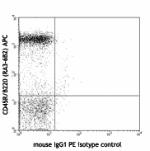
Balb/c mouse splenocytes stained with MAb-CC1 PE (lower pane... 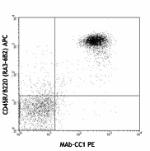
-
APC anti-mouse CD66a (CEACAM1a)
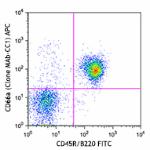
C57BL/6 mouse splenocytes were stained with CD45R/B220 FITC ... 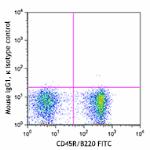
-
PE/Cyanine7 anti-mouse CD66a (CEACAM1a)

C57BL/6 mouse splenocytes were stained with CD45R/B220 FITC ... -
FITC anti-mouse CD66a (CEACAM1a)
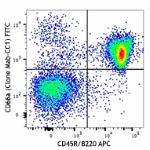
C57BL/6 mouse splenocytes were stained with CD45R/B220 APC a... 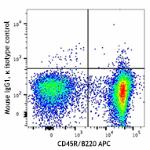
-
PerCP/Cyanine5.5 anti-mouse CD66a (CEACAM1a)

C57BL/6 mouse splenocytes were stained with CD45R/B220 Alexa... -
Alexa Fluor® 488 anti-mouse CD66a (CEACAM1a)
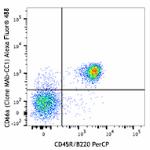
C57BL/6 mouse splenocytes were stained with CD45R/B220 PerCP... 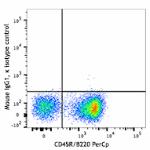
-
Alexa Fluor® 647 anti-mouse CD66a (CEACAM1a)
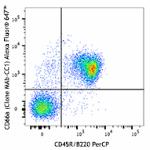
C57BL/6 mouse splenocytes were stained with CD45R/B220 PerCP... 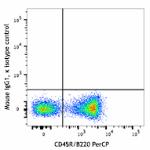
-
Purified anti-mouse CD66a (CEACAM1a)
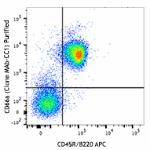
C57BL/6 mouse splenocytes were stained with CD45R/B220 APC a... -
Brilliant Violet 421™ anti-mouse CD66a (CEACAM1a)
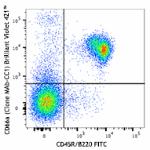
C57BL/6 mouse splenocytes were stained with CD45R/B220 FITC ... 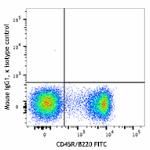
-
Brilliant Violet 650™ anti-mouse CD66a (CEACAM1a)
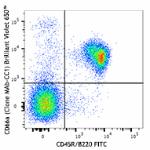
C57BL/6 mouse splenocytes were stained with CD45R/B220 FITC ... 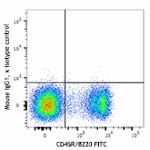
-
Ultra-LEAF™ Purified anti-mouse CD66a (CEACAM1a)

Balb/c mouse splenocytes stained with MAb-CC1 PE (lower pane... 
-
APC/Cyanine7 anti-mouse CD66a (CEACAM1a)

C57BL/6 mouse splenocytes were stained with CD45R/B220 PE an... -
Spark Blue™ 550 anti-mouse CD66a (CEACAM1a) (Flexi-Fluor™)
-
Spark Blue™ 574 anti-mouse CD66a (CEACAM1a) (Flexi-Fluor™) Antibody
-
Spark Red™ 718 anti-mouse CD66a (CEACAM1a) (Flexi-Fluor™)
 Login / Register
Login / Register 













Follow Us